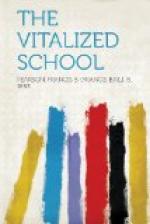=Pedagogy in literature.=—Hawthorne, in this story, must have been trying to teach the lesson of unconscious education or education by absorption, but his readers have not all been quick to catch his meaning. Teachers often take great unction in the reflection that they afford to the child his only means of education, and that but for them the child would never become educated at all. We are slow to admit that there are many sources of education besides the school, and that formal instruction is not the only road to the acquisition of knowledge. Tennyson knew and expressed this conception in the quotation already given, but we have not acquired the habit of consulting the poets and novelists for our pedagogy. When we learn to consult these, we shall find them expressing many tenets of pedagogy that are basic.
=The testimony of experience.=—But we need not go beyond our own experiences to realize that much of our education has been unconsciously gained, that we have absorbed much of it, and, possibly, what we now regard as the most vital part of it. We have but to explore our own experiences to discover some person whose standards have been effective in luring us out of ourselves and causing us to yearn toward higher levels; who has been the beacon light toward which our feet have been stumbling; who has been the pattern by which we have sought to shape our lives; and for whom we feel a sense of gratitude that cannot be quenched. The influence of that person has been a liberal education in the vital things that the books do not teach, and we shudder to think what we might have been had that influence not come into our lives. This ideal is not some mythical, far-away person, but a real man or woman who has challenged our admiration by looks, by conduct, by position, and by general bearing in society.
=The one teacher.=—This preliminary part of the subject has been dwelt upon thus at length in an effort to win assent to the general proposition that unconscious education is not only possible, but an actuality. This assent being once given, the mind feels out at once for applications of the principle and, inevitably, brings the parent and the teacher into the field of view. But the parent is too near to us in time, in space, and in relation to afford the illustration that we seek, and we pass on to the teacher. In the experience of each one of us there stands out at least one teacher as clear in definition as a cameo. This teacher may not have been the most scholarly, or the most successful in popular esteem, or even the most handsome, but she had some quality that differentiates her in our thinking from all others. Others may seem but a sort of blur in our memory, but not so this one. She alone is distinct, distinctive, and regnant.




